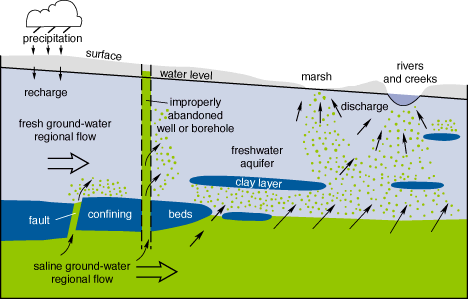


Kansas Geological Survey, Public Information Circular (PIC) 2
Salt Contamination of Ground Water in South Central Kansas--Part 3 of 5
Recharge by irrigation water and contaminated surface-water typically cause modest salinity increases in ground water, while contamination by oil-field brines and salt mining can be highly concentrated. Salt contamination associated with oil or mining activities is typically localized.
Natural sources of salt contamination of freshwater aquifers, the emphasis of this publication, include salt- and saltwater-bearing bedrock formations.
Figure 2--Schematic illustration of factors influencing movement of
saltwater from a bedrock aquifer to the overlying freshwater aquifer and surface-water
discharge areas.

Saltwater is found in deep bedrock formations almost everywhere, while freshwater is usually found only near the earth's surface. In most places freshwater aquifers are separated from saltwater-containing aquifers by barriers called confining beds. Confining beds are clay or bedrock layers that slow or prevent the vertical movement of water between aquifers. Where the confining bed is absent or penetrated by natural features such as faults or fractures, or by human-made features such as improperly abandoned wells, saltwater may leak upward and contaminate the freshwater aquifer. Within an unconsolidated aquifer, thick and extensive clay layers can function as confining beds. Where saltwater has moved above a clay layer, the clay can serve as a perching horizon, maintaining the saltwater higher than would otherwise be expected (fig. 2). Unlike large regional layers of confining bedrock, these clay layers are variable and unpredictable in their size and distribution.
Because saltwater is denser than freshwater, it remains near the bottom of aquifers and flows downgradient unless it is drawn upward by natural discharge or pumping. In some areas, the aquifer may contain substantial amounts of saltwater near its base, but the freshwater in the uppermost part of the aquifer may not be affected.
In south-central Kansas, bedrock formations containing saltwater and salt layers are in contact with the overlying freshwater aquifer. In these areas, confining beds can be thin, discontinuous, or absent (fig. 2), and freshwater aquifers are potentially vulnerable to natural salt contamination.



Kansas Geological Survey, Geology Extension
Web version Nov. 1995
http://www.kgs.ku.edu/Publications/pic2/pic2_3.html